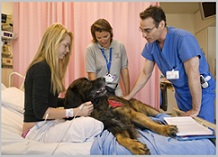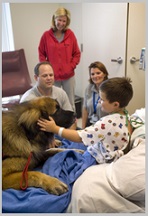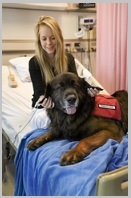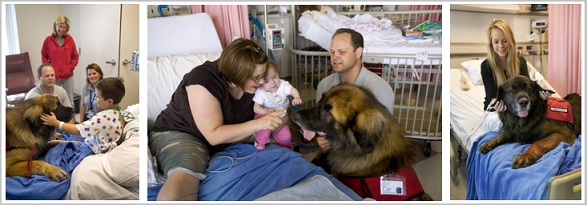Table Of Contents
Animal Assisted Therapy (AAT) : Definition, Benefits and History

It's a unique situation in which animals take on the role of assistants in various forms of therapy. This type of therapy is also called AAT. It's an activity in which an animal and handler work with a professional therapist, teacher, or doctor. Their sessions are goal-directed and individualized to the patient. They are an integral part of the treatment process.
Records are kept to measure and document the individual's progress. Goals of Animal assisted therapy can by educational, motivational, physical or mental health oriented.
Animal assisted therapy sessions can be provided in a variety of settings. They may be group or individual in nature. They can deal with a wide range of age groups and people with varying problems.
[AdSense-A]
Is That the Same as Animal Assisted Activities?
When volunteers bring a pet or a specially trained therapy dog to visit hospitals, nursing homes and other facilities for the purpose of socializing with the residents, they're engaging in Animal Assisted Activities (AAA). No specific treatment goals are planned for the visits.
No formal records are kept of the dog's effect on the people he visits. These activities provide opportunities for motivational, educational, and/or recreational benefits to enhance quality of life.
Trained therapy dogs can actually be involved in either Animal Assisted Therapy or AAA.
Why Use Animals in Therapy?.

Talking to an animal while a therapist listens is often easier than talking to the therapist directly, especially for children. The animal is seen as a friend and ally, making this feel like a safe place for sharing.
Animal assisted therapy works particularly well for very young children and children with autism. It also works well for children who do not trust adults, and for children who have difficulty focusing and sitting still.
Using dogs in an animal assisted therapy program provides powerful motivation in getting patients to do their physical therapy.
While residents of a nursing home may not cooperate in a traditional physical therapy session, they might eagerly brush a friendly Golden Retriever. In this way, they regain strength and mobility while having fun with the dog.
Working with a dog increases a person's activity level, encouraging walking and playing. Patients who don't want to get out of bed can often be coaxed to walk with a dog down hospital hallways.
Since 1990, the largest organization devoted to promoting animal assisted therapy, the Delta Society, has trained over 3,000 volunteer animal-human teams in five countries to participate in its Pet Partners program.
A great many species make wonderful therapy animals and can form a strong human-animal bond.
Several different types of animals are used in therapy as part of the Delta Society's program. These include rabbits, guinea pigs, cats, goats, pot-bellied pigs, horses, donkeys, llamas, African gray parrots, cockatoos, and chickens. But a dog is still by far the most common and popular animal therapist.
Dogs used in animal assisted therapy are the ultimate in therapy dogs. They are sometimes assigned to the most critically damaged and discouraged patients. They even work with those who have suffered a head injury or a stroke. These situations severely limit a patient's ability to interact with those around him.
Benefits of Animal Assisted Therapy

These may include improving a patient's range of motion, strength and endurance, balance, mobility, sensation, speech and cognitive functioning.
Among the specific benefits of animal assisted therapy are the ways it motivates people to:
- Do things that may be a struggle, such as eating.
- Get up, move, leave their room, and walk.
- Participate in therapy (physical, occupational, and speech).
- Interact more with family and staff.
Animal Assisted therapy is also able to:
- Increase self-esteem.
- Reduce stress levels.
- Provide a sense of well-being.
- Give the person a focus other than their disability or disease.
- Provide a welcome break from the difficulties of daily life.
- Improve one's mood.
[AdSense-A]
History of Animal Assisted Therapy.

The patients at the retreat learned to care for animals and work in a garden as part of their therapy. But it was New York child psychologist Boris Levinson who first explained the benefits of using animals to enhance therapy sessions. He outlined his findings in a paper published in 1962.
Levinson discovered that when his dog Jingles attended therapy sessions, he was able to make more progress with a disturbed child.
Levinson began using his dog in sessions with other patients. He finally found that many of the children who were usually withdrawn would interact more willingly with Jingles.
The work of Levinson and others laid the groundwork for animal assisted therapy.
The Power to Heal.
What makes this form of therapy unique is that animals--not humans--do the real work.
Time and again, these four-footed therapists have elicited nearly miraculous responses from physically traumatized hospital patients, deeply abused or troubled children, and even those who are terminally ill.
Both animal assisted therapy and animal assisted activities apply one of the strongest benefits of the human-animal bond--the power to heal.
[AdSense-A]
Similar Articles :
1- Tramadol For Dogs Toxicity.
2- Golden Retriever Lifespan .
3- Can Dogs Eat Grapes Or Not?? .
4- How To Stop Your Dog From Biting .
5- Golden Retriever Health Problems Issues.
6- Find Good Golden Retriever Forum.
7- How To Deal With An Golden Retriever Dog..
8- My Dog Ate Chocolate What Should I Do? .
9- Worming / Deworming Your Golden Retriever Puppies.
10- Golden Retriever Breed Standard.
10- How To Deal With An Aggressive Golden Retriever Dog.
11- How To Stop Your Dog From BITING.
